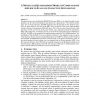7 search results - page 1 / 2 » A Molecular Quasi-Random Model of Computations Applied to Ev... |
IPPS
1998
IEEE
13 years 11 months ago
1998
IEEE
The paper presents how the Random PROLOG Processor (RPP), a bio-inspired model of computations, can be used for formalization and analysis of a phenomenon - the Collective Intelli...
AFRIGRAPH
2010
ACM
13 years 11 months ago
2010
ACM
Aligning structures, often referred to as docking or registration, is frequently required in fields such as computer science, robotics and structural biology. The task of alignin...
BMCBI
2011
13 years 2 months ago
2011
Background: Methods of determining whether or not any particular HIV-1 sequence stems - completely or in part - from some unknown HIV-1 subtype are important for the design of vac...
CIA
2007
Springer
14 years 1 months ago
2007
Springer
In this paper, we propose a probabilistic framework targeting three important issues in the computation of quality and trust in decentralized systems. Specifically, our approach a...
BMCBI
2010
13 years 7 months ago
2010
Background: As the size of the known human interactome grows, biologists increasingly rely on computational tools to identify patterns that represent protein complexes and pathway...

